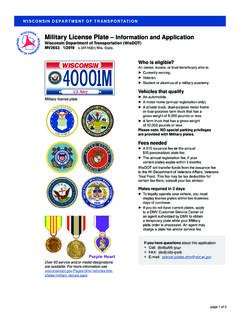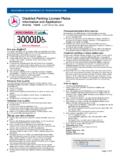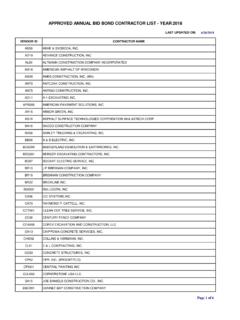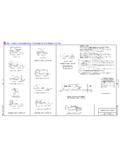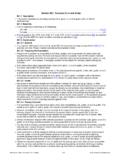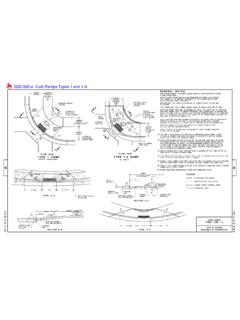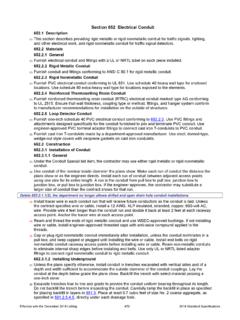Transcription of WisDOT Bridge Manual Chapter 27 – Bearings
1 WisDOT Bridge Manual Chapter 27 Bearings July 2019 27-1 Table of Contents General .. 2 Bearing Types .. 3 Elastomeric Bearings .. 4 steel Bearings .. 11 Type "A" Fixed Bearings .. 11 Type "A-T" Expansion Bearings .. 12 High-Load Multi-Rotational Bearings .. 12 Hold Down Devices .. 18 Design Example .. 19 WisDOT Bridge Manual Chapter 27 Bearings July 2019 27-2 General Bridges supported in the conventional way by abutments and piers require Bearings to transfer girder reactions without overstressing the supports, ensuring that the Bridge functions as intended.
2 Bridges usually require Bearings that are more elaborate than those required for building columns, girders and trusses. Bridge Bearings require greater consideration in minimizing forces caused by temperature change, friction and restraint against elastic deformations. A more detailed analysis in Bridge bearing design considers the following: Bridges are usually supported by reinforced concrete substructure units, and the magnitude of the horizontal thrust determines the size of the substructure units. The coefficient of friction on Bridge Bearings should be as low as possible.
3 Bridge Bearings must be capable of withstanding and transferring dynamic forces and the resulting vibrations without causing eventual wear and destruction of the substructure units. Most bridges are exposed to the elements of nature. Bridge Bearings are subjected to more frequent and greater total expansion and contraction movement due to changes in temperature than those required by buildings. Since Bridge Bearings are exposed to the weather, they are designed as maintenance-free as possible. WisDOT policy item: The temperature range considered for steel girder superstructures is -30 F to 120 F.
4 A temperature setting table for steel Bearings is used for steel girders ; where 45 F is the neutral temperature, resulting in a range of 120 - 45 = 75 for bearing design. The temperature range considered for prestressed concrete girder superstructures is 5 F to 85 F. Using an installation temperature of 60 for prestressed girders , the resulting range is 60 - 5 = 55 for bearing design. For prestressed girders , an additional shrinkage factor of ft/ft shall also be accounted for. (Do not include prestressed girder shrinkage when designing Bearings for Bridge rehabilitation projects).
5 No temperature setting table is used for prestressed concrete girders . See the Standard for steel Expansion Bearing Details to determine bearing plate A sizing ( steel girders ) or anchor plate sizing (prestressed concrete girders ). This standard also gives an example of a temperature setting table for steel Bearings when used for steel girders . WisDOT policy item: According to LRFD [ ], the influence of dynamic load allowance need not be included for Bearings . However, dynamic load allowance shall be included when designing Bearings for bridges in Wisconsin.
6 Apply dynamic load allowance in LRFD [ ] to HL-93 live loads as stated in LRFD [ , ] and distribute these loads, along with dead loads, to the Bearings . WisDOT Bridge Manual Chapter 27 Bearings July 2019 27-3 Bearing Types Bridge Bearings are of two general types: expansion and fixed. Bearings can be fixed in both the longitudinal and transverse directions, fixed in one direction and expansion in the other, or expansion in both directions. Expansion Bearings provide for rotational movements of the girders , as well as longitudinal movement for the expansion and contraction of the Bridge spans.
7 If an expansion bearing develops a large resistance to longitudinal movement due to corrosion or other causes, this frictional force opposes the natural expansion or contraction of the span, creating a force within the span that could lead to a maintenance problem in the future. Fixed Bearings act as hinges by permitting rotational movement, while at the same time preventing longitudinal movement. The function of the fixed bearing is to prevent the superstructure from moving longitudinally off of the substructure units. Both expansion and fixed Bearings transfer lateral forces, as described in LRFD [Section 3], from the superstructure to the substructure units.
8 Both bearing types are set parallel to the direction of structural movement; Bearings are not set parallel to flared girders . When deciding which Bearings will be fixed and which will be expansion on a Bridge , several guidelines are commonly considered: The bearing layout for a Bridge must be developed as a consistent system. Vertical movements are resisted by all Bearings , longitudinal horizontal movements are resisted by fixed Bearings and facilitated in expansion Bearings , and rotations are generally allowed to occur as freely as possible. For maintenance purposes, it is generally desirable to minimize the number of deck joints on a Bridge , which can in turn affect the bearing layout.
9 The bearing layout must facilitate the anticipated thermal movements, primarily in the longitudinal direction, but also in the transverse direction for wide bridges. It is generally desirable for the superstructure to expand in the uphill direction, wherever possible. If more than one substructure unit is fixed within a single superstructure unit, then forces will be induced into the fixed substructure units and must be considered during design. If only one pier is fixed, unbalanced friction forces from expansion Bearings will induce force into the fixed pier. For curved bridges, the bearing layout can induce additional stresses into the superstructure, which must be considered during design.
10 Forces are distributed to the Bearings based on the superstructure analysis. A valuable tool for selecting bearing types is presented in LRFD [Table ], in which the suitability of various bearing types is presented in terms of movement, rotation and resistance to loads. In general, it is best to use a fixed or semi-expansion bearing utilizing an unreinforced elastomeric bearing pad whenever possible, provided adverse effects such as excessive force transfer to the substructure does not occur. Where a fixed bearing is required with greater rotational capacity, steel fixed Bearings can be utilized.
